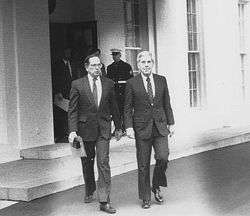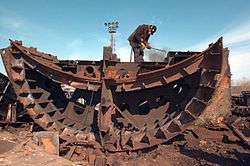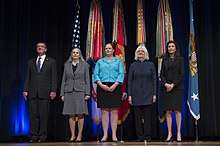Nunn–Lugar Cooperative Threat Reduction
As the collapse of the Soviet Union appeared imminent, the United States and their NATO allies grew concerned of the risk of nuclear weapons held in the Soviet republics falling into enemy hands. The Cooperative Threat Reduction (CTR) Program was an initiative housed within the Defense Threat Reduction Agency (DTRA). The CTR program is better known as the Nunn–Lugar Act based on the Soviet Nuclear Threat Reduction Act of 1991 which was authored and cosponsored by Sens. Sam Nunn (D-GA) and Richard Lugar (R-IN). This Act was created in 1986 in a congressional meeting. According to the CTR website, "the purpose of the CTR Program is to secure and dismantle weapons of mass destruction and their associated infrastructure in former Soviet Union states." An alternative explanation of the program is "to secure and dismantle weapons of mass destruction in states of the former Soviet Union and beyond".[1]

CTR provides funding and expertise for states in the former Soviet Union (including Russia, Ukraine, Georgia, Azerbaijan, Belarus, Uzbekistan, and Kazakhstan) to decommission nuclear, biological, and chemical weapon stockpiles, as agreed by the Soviet Union under disarmament treaties such as SALT I. This funding totaled $400 million a year for a total of four years. After the nuclear warheads were removed from their delivery vehicles by the post-Soviet successor militaries, Nunn-Lugar assistance provided equipment and supplies to destroy the missiles on which the warheads had been mounted, as well as the silos which had contained the missiles. The warheads themselves were then shipped to and destroyed in Russia, with the highly-enriched uranium contained within made into commercial reactor fuel; which was purchased by the United States under a separate program.
In recent years, the CTR program has expanded its mission from securing WMDs at the root source to protecting against WMD "on the move", by enhancing land and maritime border security in the former Soviet Union.
Objectives and programs
According to the CTR website, CTR has four key objectives:[2]
- Dismantle Former Soviet Union (FSU)'s Weapons of Mass Destruction (WMD) and associated infrastructure
- Consolidate and secure FSU WMD and related technology and materials
- Increase transparency and encourage higher standards of conduct
- Support defense and military cooperation with the objective of preventing proliferation
These objectives are pursued and achieved through a variety of programs.[3] Briefly, these include:
- The Cooperative Biological Engagement Program (CBEP; formerly the Biological Threat Reduction Program [BTRP])
- Chemical Weapons Elimination Program
- Nuclear Weapons Storage Security Program (NWSS)
- Strategic Offensive Arms Elimination Program (SOAE)
- Weapons of Mass Destruction-Proliferation Prevention Initiative (WMD-PPI)
The CTR program is authorized by Title 22 of the United States Code, chapter 68a.[4]
The FY 2007 CTR Annual Report to Congress provides a status update on the program as a whole and individual initiatives. It also details future planned endeavors in each area.[5]
Contributions
The Cooperative Threat Reduction Act was a major contributor to De-Escalation of nuclear weapon arsenals. This program was used for "the transportation, storage, safeguarding and destruction of nuclear and other weapons in the Soviet Union… and to assist in the prevention of weapons proliferation".[6] One contribution by the Nunn-Lugar program has been the "delivery of equipment to accelerate the dismantlement of strategic nuclear delivery vehicles" to the Soviet Union.[6] This program made important contributions in the disarmament of nuclear warheads in many counties. The Nunn-Lugar program eliminated former strategic weapons outside of Russia. This was most evident in the removal of these weapons in Ukraine.[6] There were many countries that had Soviet Union nuclear weapons. Two others included Belarus and Kazakhstan. The Cooperative Threat Reduction Act helped Russia move the nuclear arsenals in these countries back to Russia or dismembering these weapons in these countries. The United States sent "nearly 700 emergency response items to help guarantee safe and secure transportation of nuclear weapons" to Belarus for the aid of the elimination of nuclear power in this country.[7] The Cooperative Threat Reduction Act played a major role in a huge decrease in the quantity of nuclear weapons that had been stockpiled during the nuclear escalation period.
Another important contribution was when the United States sent storage containers to Russia to store fissionable material under their control. The United States provided "10,000 fissile material storage containers by the end of 1995 and a total of nearly 33,000 containers by early 1997".[7] These containers aided in Russia's ability to store nuclear material from dismantled warheads. Another contribution from the United States to Russia was "75 million dollars to help Russia build a new fissile material storage facility at Chelyabinsk for plutonium "pits" from dismantled warheads".[7] The Nuclear Threat Reduction program was not just used to remove everything fissionable from Russia; it also included ideas for safe storage and transportation of fissionable material in Russia built up during the Cold War and nuclear escalation.
Outcome

Under CTR, the U.S. and recipient states have made considerable advancements in global security against the threat of WMD. For example, weapons deactivated and destroyed under this program include:
- 537 ICBMs
- 459 ICBM silos
- 11 ICBM mobile missile launchers
- 128 bombers
- 708 nuclear air-to-surface missiles
- 408 submarine missile launchers
- 496 submarine-launched missiles
- 27 nuclear submarines
- 194 nuclear test tunnels
Other milestone results include:
- 260 tons of fissile material received security upgrades
- 60 nuclear warhead storage sites received security upgrades
- 35 percent of Russian chemical weapons received security upgrades
- 49 former biological weapons facilities were converted to joint U.S.–Russian research
- 4 biological weapons sites received security improvements
- 58,000 former weapons scientists employed in peaceful work through International Science and Technology Centers (of which the U.S. is the leading sponsor)
- 750 projects involving 14,000 former weapons scientists and created some 580 new peaceful high-tech jobs; The International Proliferation Prevention Program has funded
- Ukraine, Belarus, and Kazakhstan are nuclear weapons free[8]
Russian initiatives
Pavlograd site (Ukraine)
One Nunn–Lugar site, Pavlograd, has dedicated itself beginning in June 2004 to the decommissioning of nuclear missiles without burning their solid rocket fuel, thus preventing dioxins from threatening the local environment and human population. The Pavlograd missile factory PMZ has been converted to an advanced astronautics "Space Clipper" program.
Shchuchye chemical weapons decommission plant
In May 2009, Russia announced the opening of a major facility to decommission its chemical weapons reserves. Built near vast reserves of ex-Soviet weaponry at Shchuchye, Kurgan Oblast, in the Ural Mountains, the site is expected to destroy some 5,500 tons of chemical agents, including Sarin and VX. About one-third of the funding to build the plant, roughly $1 billion, was provided by CTR.[9]
In 2012, Russia declared that they would not extend the agreement.[10]
In June 2013, the United States and the Russian Federation signed a new bilateral framework on cooperative threat reduction intended to supersede the CTR. The new agreement is intended to reinforce the longstanding partnership on nonproliferation between these two nations and their activities in Russia and the Former Soviet Republics (FSR). "This new framework builds upon the success of the 1992 Agreement between the United States of America and the Russian Federation Concerning the Safe and Secure Transportation, Storage and Destruction of Weapons and the Prevention of Weapons Proliferation, commonly known as the Nunn-Lugar Cooperative Threat Reduction (CTR) Umbrella Agreement that expires today. This new bilateral framework authorizes the United States and the Russian Federation to work in several areas of nonproliferation collaboration, including protecting, controlling, and accounting for nuclear materials."[11]
In January 2015, Russian Federation representatives told their US counterparts that Russia would no longer accept US assistance in securing stored weapons-grade nuclear material but said they would continue the program on their own. Joint security work at numerous Russian sites and facilities was halted on 1 January 2015.[12]
Today

| Panel discussions on the 25th anniversary of the Nunn-Lugar Act, December 12, 2016 | |
|---|---|
Nuclear threat reduction is still an issue, even for current presidents. Subsequent programs have built on the Cooperative Threat Reduction, including the Proliferation Security Initiative, initially launched by President Bush in cooperation with Poland in 2003, and built on by multilateral efforts, and then by President Obama.
Although the budget for the Cooperative Threat Reduction program has been cut every year since the Obama administration began, the United States still faces many issues when it comes to agreements with Russia in nuclear arms reduction. President Obama had his own ideas for nuclear threat reduction. His plan was to reset nuclear relations with Russia. This plan included a plan to further reduce U.S. and Russian nuclear arsenals, which would further reduce the number of nuclear weapons in the world today.[13] This plan was the result of the impending expiration of the Strategic Arms Reduction Treaty (START I). START was set to expire in December 2009.[13]
In President Obama's second term, work on the nuclear threat reduction was said to be more bleak because of relations with Ukraine. This is verified in the quote "the crisis in Ukraine probably has ruined prospects for another formal Russian-U.S. arms control agreement during the Obama administration’s second term".[14] As far as reducing nuclear weapons in other countries, besides Ukraine, there is more of a chance of an agreement. This idea is explained in "countering nuclear weapons proliferation to states and to nonstate actors, the prospects are somewhat better, given mutual Russian and U.S. concerns in that area".[14] There are still many agreements that have been proposed that can be passed between the United States and Russia as far as nuclear weapons and the control and elimination of them are concerned. As time progresses, the threat of nuclear weapons and the money needed to spend on the elimination of them diminishes. The Cooperative Threat Reduction program has faced many budget cuts since its beginning in 1986 because the program was "created to deal with yesterday’s strategic weapons and yesterday’s threats have largely diminished".[15]
See also
- The World Institute for Nuclear Security
- Project Sapphire
- MPC&A
- Global Partnership Against the Spread of Weapons and Materials of Mass Destruction
- Russia and weapons of mass destruction
References
- Lugar, Richard (2009). "Cooperative Threat Reduction and Nuclear Security". Georgetown Journal of International Affairs. 10: 183–189.
- https://web.archive.org/web/20070927215354/http://www.dtra.mil/oe/ctr/programs/
- http://www.dtra.mil/oe/ctr/org_chart_ctr.cfm
- 22 U.S.C. ch. 68A — Cooperative Threat Reduction With States Of Former Soviet Union
- http://www.dtra.mil/documents/oe/ctr/FY07%20CTR%20Annual%20Report%20to%20Congress.pdf
- Lockwood, Dunbar (1995). "The Nunn-Lugar Program: No Time to Pull the Plug". Arms Control Today. 44: 18–22.
- Deni, Lockwood, John, Dunbar (1994). "U.S. Begins to Deliver Nunn-Lugar Equipment to Russia, Belarus". Arms Control Today. 24: 21.
- http://nunn-lugar.com
- "Russia opens WMD disposal plant". BBC. May 29, 2009. Retrieved May 20, 2010.
- "Russia Will Not Renew Arms Deal With US." by VOA News, 11 October 2012.
- "United States and the Russian Federation Sign New Bilateral Framework on Threat Reduction" by White House Press Release, 17 June 2013
- "Russia ends US nuclear security alliance" The Boston Globe, 19 January 2015.
- Zarate, Robert (2009). "Cooperation Against Proliferation: How the United States and Russia can Stem Future Nuclear Threats". The Brown Journal of World Affairs. 16: 59–71.
- Weitz, Richard (2014). "Russian-U.S. Cooperative Threat Reduction for Conventional Weapons Expertise". Arms Control Today. 44: 15–21.
- Liimatainen, William (2014). "Cooperative Threat Reduction for Conventional Weapons Expertise". Arms Control Today. 44: 18–22.
External links
- Space Clipper at Federation of American Scientists, Space Policy Project, World Space Guide
- Kenneth Luongo and William Hoehn, "An ounce of prevention", Bulletin of the Atomic Scientists, March/April 2005. Discusses disagreements between U.S. and Russian officials, which the authors argue is undermining cooperative threat reduction programs.